Isolation, identification and optimization of fermentation conditions against Sclerotinia sclerotiorum strains in high salt Doenjan
Xin Zhng, Hongmei Li, Xioyu Kng, Seongil Lim, Fnzhu Li,*
a Agricultural College, Yanbian University, Yanji, Jilin, China;
b Fermentation and Functionality Research Group, Korea Food Research Institute, Korea
ABSTRACT
With the global warming, the cultivation and storage of northern Chinese cabbage has been infected by Sclerotium bacteria, resulting in the whole plant rot. In this study, in order to develop a bio-inhibitory agent with antibacterial effect and no toxicity and no residue, three strains with high inhibition rate against Sclerotinia sclerotiorum were screened from 69 samples of Doenjang collected in different regions. By observing culture characteristics and physiological and biochemical tests, three strains were identified through 16S rDNA sequence and phylogenetic tree. The results showed that SP-6 was Bacillus amyloliquefaciens,SP-13 was Bacillus methylotrophicus, and SP-14 was Bacillus subtilis. Meanwhile, the inhibition rate of the aseptic fermentation filtrate of three strains against S. sclerotiorum was determined and the fermentation conditions of SP-14 strain was optimized. Results showed that all of three fermentation filtrates inhibited S. sclerotiorum. Data showed that the best conditions for fermentation for the antibacterial substances of SP-14 strain is as following: 1% maltose, 1% ammonium oxalate or beef extract, 1% ferrous sulfate, fermentation at 32 °C for 36 h, initial pH 8-9 and the inoculation amount 5%. The living bacteriostatic test showed that SP-14 strain had good inhibitory effect on S. sclerotiorum and the inhibitory effect was more significant when the bacteria concentration was 1.2 × 1011 CFU/mL.
Keywords:
Doenjang
Bacillus
Sclerotinia sclerotiorum
Antagonism
1. Introduction
Chinese cabbage is one of the most important vegetables in China. It has high yield and nutrient-rich, and it has the largest planting area among various vegetables [1]. Chinese cabbage likes a cool environment, but under the influence of the global warming, the northern autumn Chinese cabbage planting area is often attacked by high temperature [2,3], so the large-scale outbreak of bacteriophage damage causes decay and heavy losses. Vegetable farmers often use some bacteriostatic agents with high toxicity and residual residue to prevent the spread of diseases but easily cause safety hazards [4-6].Therefore, it is urgent to develop a non-toxic, non-residue and antibacterial agent with good antibacterial effect. According to reports,Bacillus megaterium A6, Bacillus subtilis NJ-18, BY-2, EDR4 have good control effects on Sclerotinia sclerotiorum [7-10], but there is no similar report on the prevention and control of S. sclerotium.
Bacillus which has a bacteriostatic effect on Sclerotium, has a wide range of sources, but relatively few reports have been screened from fermented soypaste. The naturally fermented soypaste has a relatively high concentration of salt, generally 15%-20% [11]. In this environment, the Bacillus has strong competitiveness and resistance,and is suitable for high salt environment [12,13]. Jung et al.[14] isolated the methylotrophic Bacillus sp. JJ-D34 from Korean fermented soypaste, and showed that the various peptides produced by the strain have strong antibacterial activity.
Therefore, this study isolated, screened and identified the strain against S. sclerotium from the fermented soypaste, and optimized the fermentation conditions of the strain. Finally, the live bacteriostasis test of Chinese cabbage was carried out. In order to excavate the anti-microbial resources in the sauce, and apply it to the development of new bio-inhibitors, this will have great practical significance for the safe production and storage of fruits and vegetables.
2. Materials and methods
2.1 Materials
Doenjang: 69 kinds of Doenjang from the four provinces of Jilin,Heilongjiang, Liaoning and Shandong.
Pathogen: S. sclerotiorum was kindly provided by Jilin Vegetable and Flower Research Institute.
Medium: LB nutrient agar and LB nutrient brod were purchased from Qingdao Hope Bio-Technology Co., Ltd., China, PDA agar was purchased from Shanghai bio-way technology Co., Ltd., China.Inorganic salt medium AO (g/L) among optimization of fermentation conditions: 1.0 NaCl, 1.5 K2HPO4, 0.5 KH2PO4, 0.2 MgSO4; carbon source utilization basic medium AC (g/L): adds 1 g NH4NO3to the AO; nitrogen source utilization basic medium AN (g/L): adds 1 g sucrose to the AO [15].
Control strains: Bacillus amyloliquefaciens KCTC 3002; Bacillus subtilis KCTC 3725; Bacillus methylotrophicus CGMCC 1.12669
Regents: Gram staining kit was purchased from Nantong kaihang bio-technology development co. Ltd., China, Spore stain kit was purchased from Beijing Solarbio science & technology co.Ltd., China, Micro-biochemical identification tube for bacteria was purchased from Beijing Aoboxing bio-technology co. Ltd., China,Bacterial genomic DNA extraction kit was purchased from Thermo Fisher Scientific, USA, QIAEX II gel extraction kit was purchased from Qiagen GmbH, Hilden, Germany.
2.2 Methods
2.2.1 Isolation, purification and screening of strains resistant to S. sclerotiorum
Take 10 g of Doenjang, incubate at 85 °C for 30 min and place it in a triangular flask containing 90 mL of sterile water under sterile conditions. Then seal and shake it at 30 °C for another 30 min. Collect supernatant, dilute it (dilution factor is 106-108) and take 0.1 mL of the diluent seeding on LB agar plates. The plates were incubated at 30 °C for 36 h, and then picked up different single colonies and purified on LB solid medium.
According to the method of El-Tarabily et al. [16], the isolated and purified strains against S. sclerotiorum were evaluated antagonistic effect by plate test. The plate which was seeded was used a control and the plates were incubated at 24 °C for 3-5 d. After that,the diameter of the inhibition area were measured and the experiment repeated three times.
2.2.2 Identification of strains resistant to S. sclerotiorum
The cultural characteristics, physiological and biochemical tests and 16S rDNA were oberserved to identify the strains [17,18]. 16S rDNA identification used AxyPrep bacterial genome and DNA mini kit was used to extract the antagonistic strain DNA. After PCR amplification, PCR products were examined by using 0.8% agarose gels electrophoresis. PCR products were sequenced and analyzed by using the International Nucleotide Sequence Databank to find sequence similarities. The phylogenetic tree was constructed based on comparing multiple sequences of antagonistic strains and strains with the highest homology by using DNA Star software.
2.2.3 Identified inhibition rate of fermentation filtrate on the S. sclerotiorum
The antagonistic bacteria were inoculated into LB liquid medium and shaked at 30 °C, 160 r/min for 5 d. After that, the bacterial solution were centrifuged at 10 000 r/min for 15 min, and the supernatant were filtered through a 0.2 μm microporous membrane to obtain sterile fermentation filtrate. The growth rate method was used to determine the inhibition rate [19]. The filtrate and PDA solid medium were mixed at a ratio of 2:8 (V/V), and then the pathogen was inoculated into the center of the plate. The medium without the filtrate was used as a control, the pathogen colony diameter was determined by the cross method and calculated inhibition rate (Equ 1). Each test was repeated 3 times.

2.2.4 Optimization of fermentation conditions for antagonistic strain SP-14
2.2.4.1 Preparation of strain seed solution
The antagonistic strains which were stored at 4 °C were inoculated onto LB plates, incubated at 30 °C for 48 h, then inoculated into 100 mL of LB liquid medium, and incubated at 30 °C, 160 r/min for 24 h with shaking.
2.2.4.2 Effect of carbon source, nitrogen source and inorganic salt on the inhibition rate of fermentation filtrate
These experiments were carried out according to the previously described method [20,21] with some modification. Optimization of carbon source was as follows: add 1% glucose, sucrose, dextrin,maltose and soluble starch to the carbon source basal medium AC.The AC used as a control, 50 mL of medium added to the triangle bottle and inoculated 1% seed solution. The bottle was placed in a shaker at 30 °C and 160 r/min for 36 h. Then, the inhibition rate of the fermentation filtrate was evaluated to determine the optimum carbon source. Optimization of nitrogen source was as follows:1% ammonium oxalate, peptone, tryptone, yeast extract and beef extract were added to the nitrogen source basal medium AN. The AN was used as the control, the loading volume, inoculum quantity and culture conditions are optimized same as carbon sources.Optimization of inorganic salt was: add 1% sodium chloride, ferrous sulfate, magnesium sulfate, copper sulfate and dipotassium hydrogen phosphate to the medium containing the best carbon source and nitrogen source (both contents are 1%). The best carbon source and nitrogen source were used a control and the loading volume, inoculum quantity and culture conditions were optimized.
2.2.4.3 Effect of culture conditions on the inhibition rate of fermentation filtrate
Based on the optimization results of carbon source, nitrogen source and inorganic salt, the culture conditions were further optimized by measuring the inhibition rate of the fermentation filtrate. The shaking speed was fixed at 160 r/min, fermentation time,temperature, initial pH and inoculum quantity were as shown in Table 1.Fermentation time was determined by measuring the inhibition rate of the fermentation filtrate under different culture conditions at 30 °C and 1% of inoculum quantity. Optimization of fermentation temperature was based on the optimal time determined above and the inoculum quantity was 1%. The inhibition rate of the fermentation filtrate was determined after incubation at different temperatures. pH was adjusted with 0.1 mol/L HCl and 0.1 mol/L NaOH solutions. Based on the best fermentation time and temperature determined above and the inoculum quantity was 1%. The inhibition rate of the fermentation filtrate was determined after incubation at different pH. Optimization of inoculum quantity was determined by measuring the inhibition rate of the fermentation filtrate after culturing at the optimal time, temperature and pH determined above with different inoculum quantity.

Table 1Optimization factors for antagonistic strains culture conditions.
2.2.5 Antibacterial test of SP-14 strain against S.sclerotiorum
The SP-14 strain seed solution was prepared as same as in 2.2.4. The seed solution of SP-14 strain was inoculated into 200 mL LB liquid medium with 5% inoculum quantity and cultured at 30 °C,160 r/min for 36 h. After that, centrifuged at 6 000 r/min for 25 min and the supernatant was decanted. The bacterial solution diluted with sterile water to the concentration of 1.2 × 1011, 1.2 × 109and 1.2 × 107CFU/mL.
The Chinese cabbage with clean appearance, no mechanical damage and disease were chosen, soaked it in 0.1% sodium hypochlorite solution for 2 min for disinfection, rinsed with tap water for about 5 min and dried it for use [22]. 25 mL of solution with different SP-14 concentrations of bacterial liquid were evenly sprayed on each Chinese cabbage, and theS. sclerotiorumwas inoculated after 24 h later. Using the injury inoculation method, three holes were added to each Chinese cabbage and 1/4 of the bacterial cakes were added to each well (the diameter of the cake was 5 mm). Each group was treatment of 2 Chinese cabbages and repeated 3 times.Inoculation ofS. sclerotiorumwas used as a control and set the blank control group at the same time.
After inoculation of bacteria at 24 °C, the humidity was controlled at 85%-95%, placed for 7 days and observed daily. Then the diameter of the lesion was measured by the cross method and the disease index (Euq 2)and prevention effect (Equ 3) were recorded [23].

2.3 Statistical analysis
Data were analyzed by Duncan’s multiple range test using SPSS software version of 17.0.
3. Results and discussion
3.1 Screening of strains resistant to S. sclerotiorum in Doenjang
228 strains were isolated and purified from 69 kinds of Doenjang from different regions. The strains were numbered SP-1-SP-228 and the screening results showed that there were 57 strains which had antagonistic activity againstS. sclerotiorum. Among the 57 strains, there were 25 strains with strong antagonistic activity againstS. sclerotiorumand the results were shown in Table 2. As shown in Table 2, the inhibition rate of these 25 strains againstS. sclerotiorumis more than 60%. The SP-6, SP-13 and SP-14 strains have higher inhibition rates, which are more than 85%. Therefore, these 3 strains were selected for subsequent experiments.

Table 2Inhibition effect of strains against S. sclerotiorum in Chinese cabbage.
3.2 Identification of strains resistant to S. sclerotiorum
3.2.1 Observation of culture characteristics
The colony morphology of the three test strains (SP-6, SP-13, SP-14) and three control strains (CS-1, CS-2, CS-3) on the PDA solid medium was observed and the results are shown in Table 3. It is shown that all the three strains have no wrinkles, both SP-6 and SP-13 are white but there are differences in the uniformity of the protrusions and edges. The SP-6 strain has large protrusions and irregular edges.CS-1 and CS-3 colonies in the control strain were wrinkled on the surface and raised in the middle, but CS-2 was unwrinkled and flat.SP-14 differs from SP-6 and SP-13 in color, transparency and shape.SP-14 is yellowish brown, transparent and with a small round shape,but has the same edge as SP-13. CS-2 and CS-3 in the control strain were white with relatively neat edges, while CS-1 was off-white with irregular edges.

Table 3Colony characteristics of strains against S. sclerotiorum in Chinese cabbage.
3.2.2 Physiological and biochemical characteristics
The physiological and biochemical characteristics results of the three strains are shown in Table 4 and Table 5. As shown in Table 4,all three strains can be oxidative fermented by using glucose, sucrose,and lactose. Only SP-14 strain produced gas during fermentation.The V-P and methyl red test showed that all three strains can produce pyruvic acid after breaking down glucose. Meanwhile, all of the three strains can broke down the tryptophan in the peptone to form hydrazine and utilized citric acid. All of the strains contained oxidase and catalase but did not contain DNase, indicating that the strains did not act on the pathogenic DNA to inhibit its growth (Table 5).The substrate utilization test results indicated that all three strains were able to utilize starch and gelatin but only SP-6 strain cannot decompose casein. Gram staining results of three strains were all positive, indicating that the peptidoglycan layer in the bacteria cell wall is thick, the degree of cross-linking is high, and the low lipoid substance content, which may be related to the strains have strong resistance. According to the physiological and biochemical characteristics test, the results were similar to the three control strains,and are most likely to be of the genusBacillusorPaenibacillus. Thus,the strains were further identified by 16S rDNA sequence.
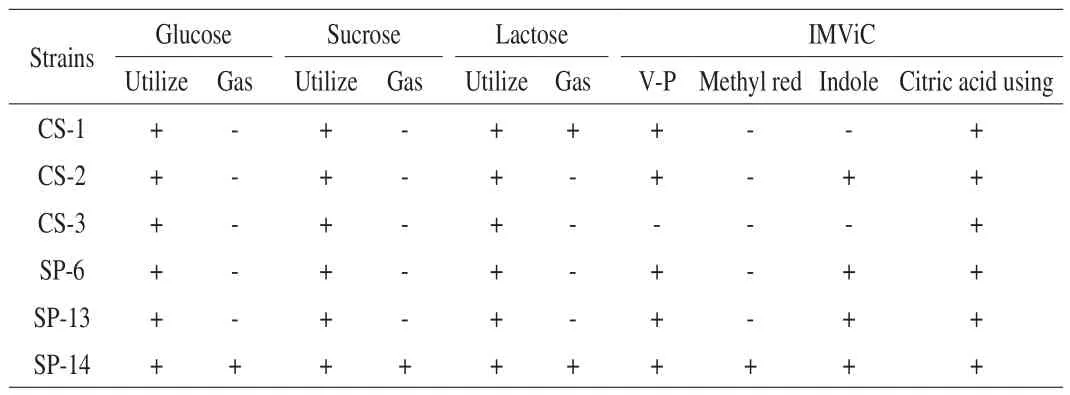
Table 4 Oxidation and fermentation tests and IMVIC test of strains against S. sclerotiorum in Chinese cabbage.

Table 5Enzyme test, substrate utilization test and gram staining of strains against S.sclerotiorum in Chinese cabbage.
3.2.3 16S rDNA gene sequence determination and phylogenetic tree
SP-6, SP-13 and SP-14 strains were identified based on 16S rDNA sequence homology analysis and BLAST score. As shown in Fig. 1A,SP-6 is more closely related toB. amyloliquefaciensBDH27 (GenBank accession number: KF933622.1) and the BLAST score is also the highest(Max Score is 2652), so SP-6 was identified asB. amyloliquefaciens. As shown in Fig. 1B, SP-13 was closely related toB. methylotrophicusL07(GenBank accession number: JN700123.1) and the BLAST score was the highest (Max Score score is 2651), so SP-13 was also identified asB. methylotrophicus. According to the 16S rDNA sequence homology analysis and phylogenetic analysis (Fig. 1C), SP-14 was closely related toB. subtilisY1 (GenBank accession number: JQ579620.1) and BLAST score was 2652, so SP-14 was identified asB. subtilis.
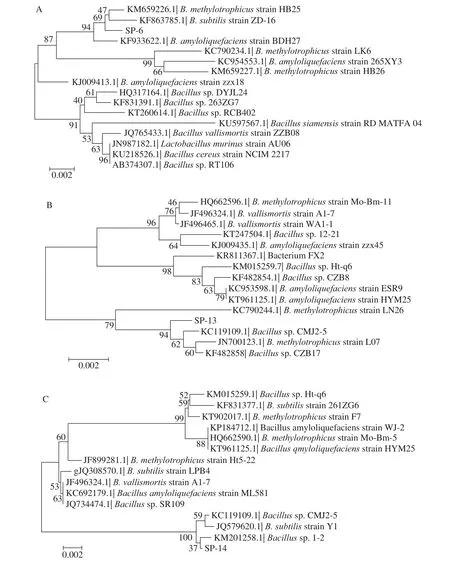
Fig. 1. Phylogenetic tree of strains agaist S. sclerotiorum in Chinese cabbage. A, SP-6; B, SP-13; C, SP-14.
3.3 Antibacterial rate of fermentation filtrate on S.sclerotiorum
As shown in Table 6, the fermentation filtrates of SP-6, SP-13 and SP-14 strains had a certain inhibitory effects onS. sclerotiorumand the inhibition rates were 47.68%, 44.90%, and 63.45%, respectively.Results indicated that these strains produced antibacterial substances after fermentation culture. The fermentation filtrate of SP-14 strain had the highest inhibition rate againstS. sclerotiorum, In order to further improve the antibacterial effect, SP-14 strain was selected to optimize the fermentation conditions.

Table 6Inhibition of fermentation filtrates of strains against S. sclerotiorum in Chinese cabbage.
3.4 Optimization of fermentation conditions of SP-14 strain
3.4.1 Effect of carbon source, nitrogen source and inorganic salt on the antibacterial effect of SP-14 fermentation filtrate
3.4.1.1 Effect of carbon source on the antibacterial effect of SP-14 fermentation filtrate
Based on results of physiological and biochemical oxidative fermentation test, we can conclude that the tested strains can grow well on a medium which is containing simple sugars. The strain fermentation filtrate of SP-14 was cultured on different carbon sources and evaluated the antibacterial activity against S.sclerotiorum were shown in Fig. 2. Results indicated that maltose,glucose and sucrose were more suitable as the antibacterial substance compared to soluble starch, indicating that the ability of SP-14 utilize monosaccharides and disaccharides was better than that of starch. Among them, maltose has the highest inhibition rate against S. sclerotiorum. Therefore, maltose was chosen as carbon source suitable for SP-14 strain fermentation.
3.4.1.2 Effect of nitrogen source on the antibacterial effect of SP-14 fermentation filtrate
The effect of different nitrogen sources on the inhibition rate of SP-14 fermentation filtrate were shown in Fig. 3. When ammonium oxalate and beef extract were used as nitrogen sources, the inhibition rate of fermentation filtrate againstS. sclerotiumwere 49.70% and 47.10%, respectively. Compared with other nitrogen sources, it has significant antibacterial effect. However, there are no significant effect when compared with peptone, tryptone and yeast extract. In general, ammonium oxalate and beef extract as an available quick impact nitrogen sources are superior to the delayed nitrogen sources such as peptone and tryptone in short-time fermentation. The results were compatible with the Xu et al. [24] which was reported that the available nitrogen source was easy to be used by strain than delayed nitrogen source.
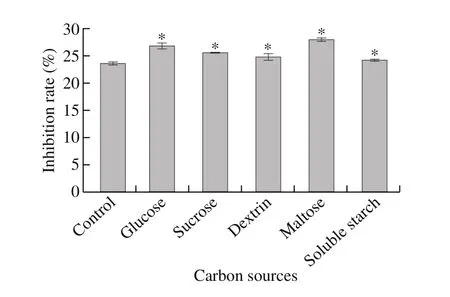
Fig. 2. Effect of carbon source on bacteriostatic effect of SP-14 strain fermentation filtrate. * P < 0.05 vs. control group.
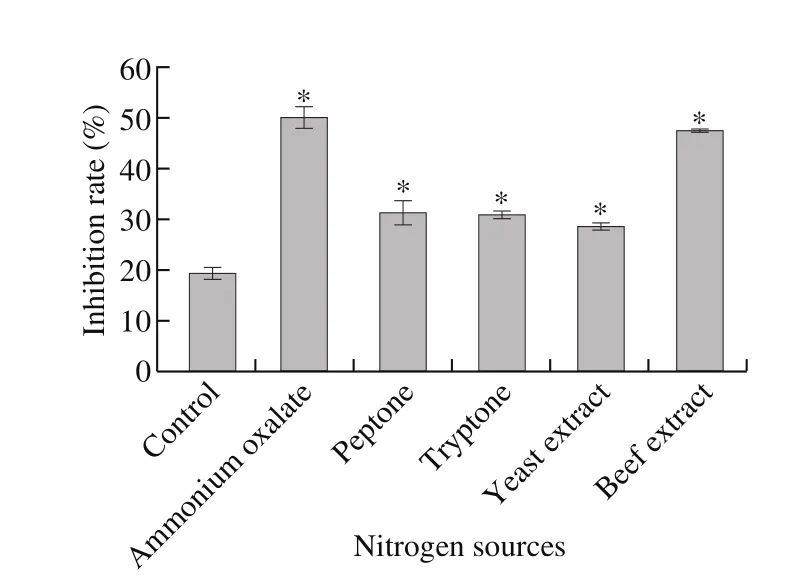
Fig. 3. Effect of nitrogen sources on bacteriostatic effect of SP-14 strain fermentation filtrate. * P < 0.05 vs. control group. * P < 0.05 vs. control group.
3.4.1.3 Effect of inorganic salts on the antibacterial effect of fermentation filtrate
The different inorganic salts on the antibacterial effect of SP-14 fermentation filtrate were shown in Fig. 4. When 1% ferrous sulfate and 1% copper sulfate were added, there are significant inhibition effects againstS. sclerotiumon. The inhibition rate ofS. sclerotiumand the inhibition rates were 100% and 90.46%,respectively. Dipotassium hydrogen phosphate and sodium chloride were also beneficial to the strains producing antibacterial substances and the inhibition rates were 39.74% and 26.80%, respectively.There was no significant difference between magnesium sulfate and the control group. Jiang et al. [25] showed that ferrous sulfate has antibacterial effect and can kill bacteria at a certain concentration,butBacillusis not sensitive to it. Ye et al. [15] showed that ferrous sulfate was beneficial toBacillusproducing antibacterial substances,so the ferrous sulfate may inhibitS. sclerotiorumand contribute to SP-14 strain produce antibacterial substance, which was made fermentation filtrate with 100% inhibition rate. Ferrous sulfate and copper sulfate have such high bacteriostatic rates may be related to concentration, which need further investigation. Since the inhibition rate of ferrous sulfate and copper sulfate is too high, which may affect the optimization of subsequent culture conditions. Therefore, we chose dipotassium hydrogen phosphate for subsequent optimization experiments.
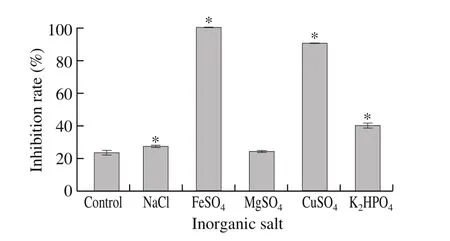
Fig. 4. Effect of inorganic salts on bacteriostatic effect of SP-14 strain fermentation filtrate. * P < 0.05 vs. control group.
3.4.2 Effect of culture conditions on the antibacterial effect of SP-14 fermentation filtrate
3.4.2.1 Effect of fermentation time on antibacterial effect of fermentation filtrate
The effects of different fermentation time on the antibacterial substances produced by the strains are shown in Fig. 5. With the prolongation of fermentation time, the inhibition rate of the fermentation filtrate againstS. sclerotiumincreased firstly and then decreased. There are no significant effects on antibacterial substances production when the fermentation time is either 12 h or 48 h, which may be due to the fact that the fermentation time was too short then the bacteria reproduction was less and the antibacterial substances produced less, as well. On the contrary, the fermentation time is adverse. For example, the nutrients in the medium consumed, the reproduction reduced, harmful metabolites accumulated, bacterial morphology, physiological traits changed, which will finally reduce the antibacterial activity [26]. The inhibition rates were 36.73% and 39.97% at 24 and 36 h, respectively. Statistical analysis showed that there was a significant difference in both, so the optimal fermentation time was 36 h.
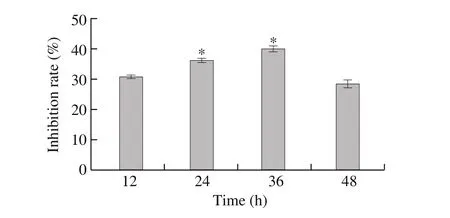
Fig. 5. Effect of fermentation time on bacteriostatic effect of SP-14 strain fermentation filtrate. * P < 0.05 vs. control group.
3.4.2.2 Effect of fermentation temperature on the antibacterial effect of fermentation filtrate
Previous studies have shown that the growth rate and the number of spores ofBacillusgrown rapidly in the liquid environment at 28-32 °C [27,28]. As shown in Fig. 6, along with temperature increase the inhibition rate of the fermentation filtrate on theS. sclerotiorumwas increased firstly and then decreased. The temperature range 30-32 °C were suitable for SP-14 strain to produce antibacterial substance and the inhibition rate reached to maximum(53.61%) at 32 °C. Therefore, we chose 32 °C as the optimum fermentation temperature for the strain.
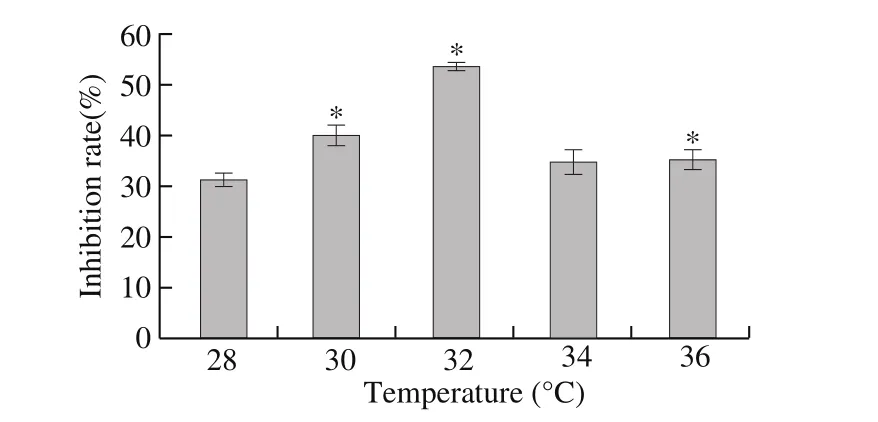
Fig. 6. Effect of fermentation temperature on bacteriostatic effect of SP-14 strain fermentation filtrate. * P < 0.05 vs. control group.
3.4.2.3 Effect of initial pH on the antibacterial effect of fermentation filtrate
pH can affect the thallus membrane charge, membrane permeability and nutrient ionization, thus affect the absorption of nutrients [29]. The pH is not easy to control during fermentation,so we evaluated the antibacterial effect of different initial pH on the fermentation filtrate. Fig. 7 showed that when the pH ranged from 6 to 9, the fermentation filtrate had a higher inhibition rate of more than 50%, indicating that the SP-14 strain has a broad pH range for producing antibacterial substances and the best inhibition rate showed at pH 8 and 9.There are no significant differences, indicating that it was more suitable for producing antibacterial substances. Jin et al. [30] showed that the optimum initial pH ofB. subtilisMBS was 8, therefore, the results of this experiment were basically consistent with it.
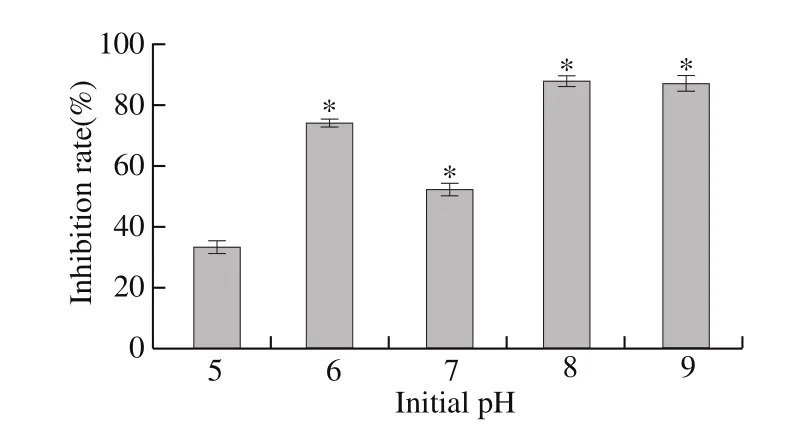
Fig. 7. Effect of initial pH on bacteriostatic effect of SP-14 strain fermentation filtrate. * P < 0.05 vs. control group.
3.4.2.4 Effect of inoculation quantity on antibacterial effect of fermentation filtrate
The inhibition rate of SP-14 fermentation filtrate againstS.sclerotiorumunder different inoculation quantity are shown in Fig.8. It showed that the inhibition rate of the fermentation filtrate on theS. sclerotiumwas increased firstly and then decreased with the increase of the inoculum quantity. When the inoculum quantity was 5%, the maximum inhibition rate was 84.70%, which was significantly higher than others. The inhibition rate of the inoculation level indicates that too much or too small inoculum quantity were not good for growth and reproduction. Therefore, the optimal inoculum quantity of SP-14 strain was 5%. However, this result was inconsistent with Yang et al. [31] and Ye et al. [15], whose results showed that the optimal inoculum of antibacterial substances produced byB. subtiliswas 2% and 1%. These results may be related to the growth period and physiological characteristics of the strain.
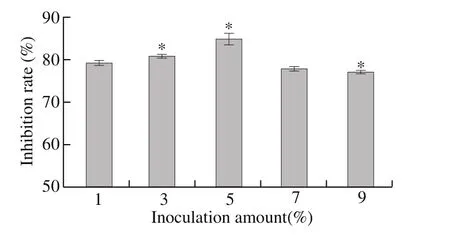
Fig. 8. Effect of inoculum size on bacteriostatic effect of SP-14 strain fermentation filtrate. * P < 0.05 vs. control group.
3.5 In vivo antibacterial test of SP-14 strain against S.sclerotiorum
The pathogenesis inhibition effect of SP-14 on the Chinese cabbage injury inoculation againstS. sclerotiorumwas shown in Table 7. It showed that the disease index gradually increased with the prolongation of storage time. The results indicating that the incidence gradual increased but the treatment group was significant lower than that of the control group. The disease index of the treatment group of 1.2 × 1011CFU/mL was significantly lower than that of the other treatment groups, indicating that the treatment of SP-14 with different concentrations inhibited theS. sclerotiorumand the concentration of 1.2 × 1011CFU/mL treatment group was the most significant. Among them, the concentration of 1.2 × 1011CFU/mL treatment group inhibition rate was 28.14%-45.81%, which was significantly higher than that of concentration of 1.2 × 109and 1.2 × 107CFU/mL treatment group during the whole storage period.These results indicated that SP-14 strain has an inhibition effect againstS. sclerotiorumand the control effect became more significant when the bacterial concentration increased. Fig. 9 is a picture of a live bacteriostatic test.

Fig. 9. Photograph of live bacteriostatic experiments of seventh days.
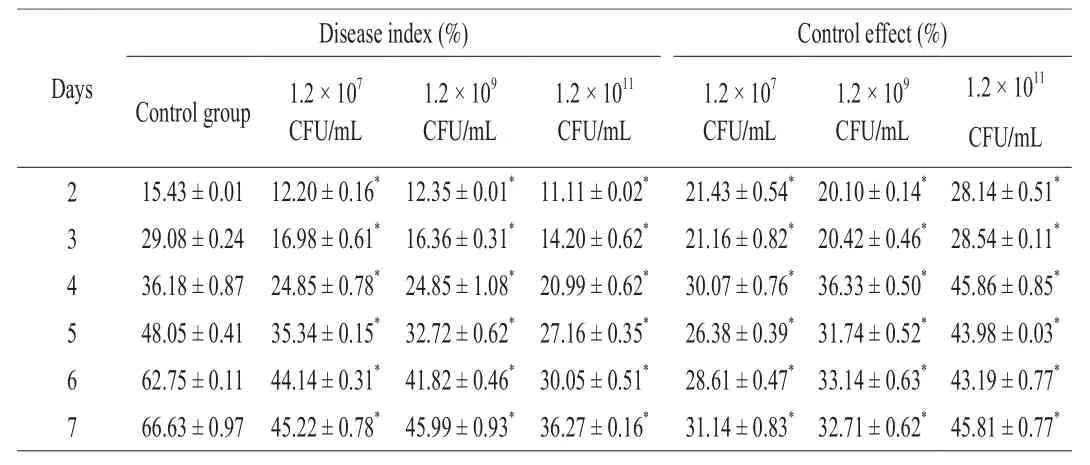
Table 7Effect of SP-14 on disease index and control effect of S.sclerotiorum in Chinese cabbage.
4. Conclusions
In this experiment, 25 strains with high antagonistic activity against S. sclerotiorum were isolated from the Doenjang and the inhibition rate were all above 60%. Among them, SP-6, SP-13 and SP-14 had high antagonism efficiency and the bacteriostasis rate were 86.21%,87.59% and 85.83%, respectively. The three strains were identified as B.amyloliquefaciens, B. Methyl nutritional and B. subtilis.
The fermentation filtrates of SP-6, SP-13 and SP-14 strains had a certain inhibitory effects on S. sclerotiorum, and the inhibition rates were 47.68%, 44.90% and 63.45%, respectively. Results indicated that the strains produced antibacterial substances during fermentation.
Optimization of fermentation conditions showed that the most suitable carbon source for SP-14 strain was maltose, the most suitable nitrogen source was ammonium oxalate or beef extract, and the most suitable inorganic salt was ferrous sulfate. However, the significant influence on ferrous sulfate needs further exploration. The suitable fermentation temperature was 32 °C, the suitable time was 36 h, the suitable initial pH was 8-9 and the inoculum quantity was 5%.
The results of living bacteriostatic test showed that SP-14 strain had good control effect on Chinese cabbage Sclerotinia. When the fermentation filtrates concentration was 1.2 × 1011CFU/mL, the control effect reached to 45%.
Conflict of Interest
The authors declare no conflict of interests.
Acknowledgements
This work was supported by Korea Food Research Institute(413090036) and Rural Development Administration of Korea(413090037). We appreciate the generous supply of S. sclerotiorum strains from Jilin Province Vegetable Research Institute.
- 食品科學(xué)與人類健康(英文)的其它文章
- Internal connections between dietary intake and gut microbiota homeostasis in disease progression of ulcerative colitis: a review
- Predominant yeasts in Chinese Dong fermented pork (Nanx Wudl) and their aroma-producing properties in fermented sausage condition
- Isolation and identification of fungi found in contaminated fermented milk and antifungal activity of vanillin
- The association between folic acid supplementation, maternal folate during pregnancy and intelligence development in infants: a prospective cohort study
- Investigation of physicochemical, microbiological and sensorial properties for organic and conventional retail chicken meat
- Preparation and physicochemical/antimicrobial characteristics of asparagus cellulose films containing quercetin

